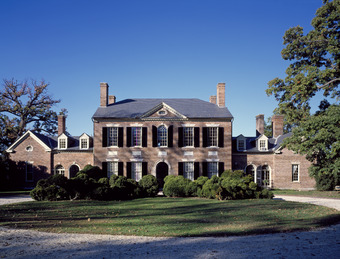Woodlawn (Alexandria, Virginia) facts for kids
|
Woodlawn Plantation
|
|

Woodlawn's east front
|
|
| Location | West of junction of U.S. 1 and Rte. 235, Alexandria, Virginia |
|---|---|
| Built | 1800–1805 |
| Architect | Dr. William Thornton |
| Architectural style | Federal |
| NRHP reference No. | 70000792 (original) 11000836 (increase) |
Quick facts for kids Significant dates |
|
| Added to NRHP | February 26, 1970 |
| Boundary increase | November 18, 2011 |
| Designated NHL | August 6, 1998 |
Woodlawn is an old and important house in Fairfax County, Virginia. It was once part of Mount Vernon, George Washington's large farm estate. Later, people who were against slavery divided the land. They wanted to show that working without forced labor could be successful.
Today, you can find Woodlawn at 9000 Richmond Highway in Alexandria, Virginia. Because of changes to nearby roads and Fort Belvoir, you reach it by Woodlawn Road. This house is a special national landmark. It is important because of its connection to the Washington family. It also played a big part in saving historic places. The National Trust for Historic Preservation now owns and manages Woodlawn as a museum.
Contents
The Story of Woodlawn House
George Washington planned for this house to have a great view. It would overlook Dogue Creek and be seen from Mount Vernon. In 1799, he gave the land as a wedding gift. It was a huge gift: 2,000 acres of land, plus a gristmill and a distillery. The gift was for his nephew, Lawrence Lewis, and Martha Washington's granddaughter, Eleanor Parke Custis Lewis. She was raised at Mount Vernon.
Washington asked William Thornton to design the house. Dr. Thornton was a famous architect. He had designed the U.S. Capitol. Building the house started in 1800 and finished in 1805.
New Owners and New Ideas
In 1846, Eleanor Custis Lewis sold Woodlawn. A group of Quakers from New Jersey bought it. They were led by Chalkley Gillingham and Jacob Troth. Quakers believed in fairness and were against slavery. They harvested wood from the land. Then, they divided it into smaller farms. They wanted to prove that a system using free labor could work well.
In 1850, Jacob Troth gave the mansion to his son, Paul Hillman Troth. The Quakers also started a cemetery and built a meetinghouse nearby in 1851.
In 1853, the Quakers sold Woodlawn house and some land to John Mason. He was a Baptist and also refused to use forced labor. By 1859, he and his wife ran a Sunday School there. After the American Civil War, his sons started a Baptist church and burial ground. This was across from the Quaker meetinghouse.
Saving Woodlawn's History
Woodlawn's main house has needed repairs many times. But all its owners knew it was important. They worked hard to keep its special character. Over the years, parts of the property were sold. Some land was also added to Fort Belvoir.
Oscar Underwood, a former U.S. Senator, retired to Woodlawn. He was known for fighting against groups that caused problems before World War II. He passed away at Woodlawn in 1929. By 1970, only about 160 acres remained around the mansion. Today, about 126 acres are left. Since 1965, another special house, the Pope-Leighey House, has also been on the Woodlawn estate.
Woodlawn Today: A Museum and More
The National Trust for Historic Preservation owns and runs Woodlawn as a museum. It was the first property the National Trust ever bought. This happened in the late 1960s. Many people helped, including Paul Mellon, who gave a lot of money.
Woodlawn and the nearby Pope-Leighey House are open to visitors. You can visit them Friday through Monday from April until mid-December. There is an admission fee. The property is called Woodlawn & Pope-Leighey House. It also hosts special events, like weddings and an annual Needlework Show.
Adding to the Estate
In 1965, a house designed by architect Frank Lloyd Wright was moved to Woodlawn. This house was built in 1940 for Loren Pope. It had to be moved because of the construction of Interstate 66.
In 1969, Woodlawn was nominated for the National Register of Historic Places. It was approved in 1970. Woodlawn was named a U.S. National Historic Landmark in 1998. Its boundaries grew a bit in 2011. This happened when Fort Belvoir donated land that was once part of Woodlawn. The Quaker meetinghouse, which was part of the original plantation, was added to the National Register in 2009.
Since 2010, Arcadia Farm has leased land at Woodlawn. They show how to grow food in a way that helps the environment. This is part of the Arcadia Center for Sustainable Food and Agriculture.
New Exhibits and Stories
In April 2024, Woodlawn opened two new exhibits. These exhibits aim to tell more stories about the people who lived on the land. "Woodlawn: People & Perspective" explores Woodlawn's connections to African-American history. "Offerings for the Tauxenent: Acknowledging Indigenous People" is another exhibit. It was put together by Gabrielle Tayac. This exhibit honors the Doeg people, who lived on the site before it became a farm. The Doeg left few artifacts. So, this exhibit shows art made by modern native groups to remember the Doeg.
There is another old farm called Woodlawn on the Rappahannock River in Virginia. That Woodlawn is part of the Woodlawn Historic and Archeological District, recognized in 1990.
See also




